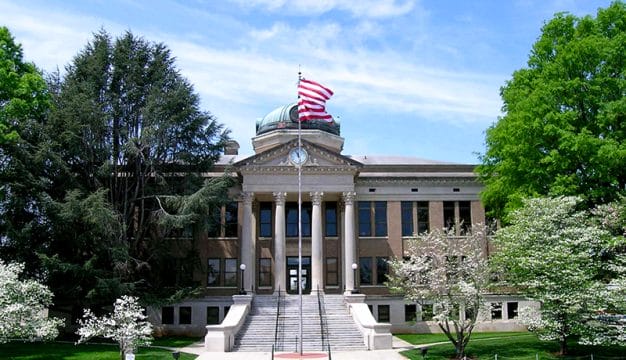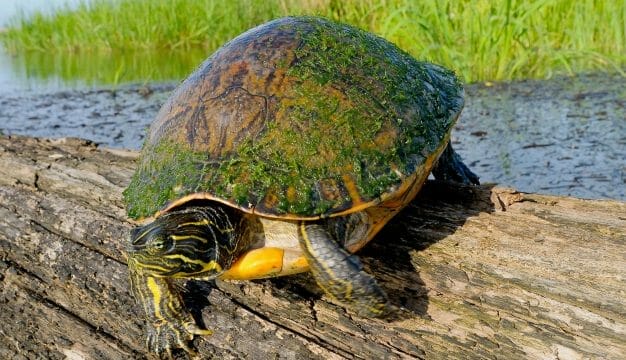George Washington Carver
 George Washington Carver
Probably one of the most recognized names in agricultural research, George Washington Carver (ca. 1865-1943) overcame numerous obstacles to achieve a graduate education and gain international fame as an educator, inventor, and scientist. Carver was born near the end of the Civil War on the farm of Moses and Susan Carver in Diamond Grove, Missouri, and he and his brother, Jim, were raised by the Carvers after their biological mother, a slave on the farm, was captured by slave raiders. Neighbors quickly recognized Carver as an exceptional child with a gift for understanding the natural world around him. He could not attend Diamond Grove’s whites-only public school, however. To further his education, Carver moved to nearby Neosho, only to be disappointed to learn that his teacher knew little more than he did. Going next to Fort Scott, Kansas, Carver began a lengthy odyssey in search of a good education.
George Washington Carver
Probably one of the most recognized names in agricultural research, George Washington Carver (ca. 1865-1943) overcame numerous obstacles to achieve a graduate education and gain international fame as an educator, inventor, and scientist. Carver was born near the end of the Civil War on the farm of Moses and Susan Carver in Diamond Grove, Missouri, and he and his brother, Jim, were raised by the Carvers after their biological mother, a slave on the farm, was captured by slave raiders. Neighbors quickly recognized Carver as an exceptional child with a gift for understanding the natural world around him. He could not attend Diamond Grove’s whites-only public school, however. To further his education, Carver moved to nearby Neosho, only to be disappointed to learn that his teacher knew little more than he did. Going next to Fort Scott, Kansas, Carver began a lengthy odyssey in search of a good education.
During his travels, he witnessed a lynching in Fort Scott in 1879, and as he noted some 60 years later, the horror of the scene still haunted him. In the summer of 1880, Carver opened a laundry in Minneapolis, Kansas, where he lived four years. Hearing of a college in Highland, Kansas, Carver applied and was accepted by mail, only to be turned away once his color was known. He next tried homesteading in Ness County, Kansas, and completed a sod house in April 1887. In each location, Carver was generally accepted by the white inhabitants, who were impressed by his abilities as an artist and naturalist. In the late 1880s, he made his way to Winterset, Iowa, where a white couple encouraged him to apply to Simpson College in Indianola, Iowa.
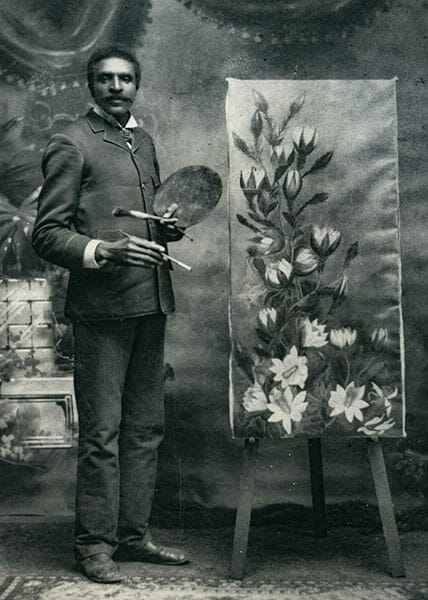 Carver, George Washington
The only African American student, Carver enrolled in Simpson in September 1890 as an art major. His art teacher recognized his considerable talents, but she was concerned that as a black man, he would have difficulties finding work as a professional artist. After Carver showed her some plants he had hybridized, she suggested that he transfer to Iowa State College of Agricultural and Mechanic Arts (now Iowa State University), in Ames, Iowa, where her father, J. L. Budd, taught horticulture. Again the only black student on campus, Carver did not receive a warm welcome at first. Active in campus affairs, he soon won over both students and faculty. He also excelled in the classroom, impressing the leading faculty in agriculture, graduating with an undergraduate degree in 1894. Recognizing his talents, the faculty encouraged him to remain at Iowa State as a graduate student. While completing his master’s degree, he took care of the greenhouse and taught freshman botany. The department was prepared for Carver to become a full-time faculty member, but after graduating in 1896, he received an offer that would change the course of his life and the history of Alabama.
Carver, George Washington
The only African American student, Carver enrolled in Simpson in September 1890 as an art major. His art teacher recognized his considerable talents, but she was concerned that as a black man, he would have difficulties finding work as a professional artist. After Carver showed her some plants he had hybridized, she suggested that he transfer to Iowa State College of Agricultural and Mechanic Arts (now Iowa State University), in Ames, Iowa, where her father, J. L. Budd, taught horticulture. Again the only black student on campus, Carver did not receive a warm welcome at first. Active in campus affairs, he soon won over both students and faculty. He also excelled in the classroom, impressing the leading faculty in agriculture, graduating with an undergraduate degree in 1894. Recognizing his talents, the faculty encouraged him to remain at Iowa State as a graduate student. While completing his master’s degree, he took care of the greenhouse and taught freshman botany. The department was prepared for Carver to become a full-time faculty member, but after graduating in 1896, he received an offer that would change the course of his life and the history of Alabama.
In 1881, African American educator and author Booker T. Washington had established Tuskegee Normal and Industrial Institute (now Tuskegee University) in Tuskegee, Macon County, Alabama, to provide educational opportunities to African Americans in the Black Belt. By 1896, he had built the school into an internationally respected center of learning, staffed entirely by black administrators and faculty. That year, Washington established a new school of agriculture and an agricultural experiment station and sought a top person to serve as its head. He wrote Carver, and begged him to come to Tuskegee. Carver accepted the offer, intending to remain only a few years before returning to school for his doctorate.
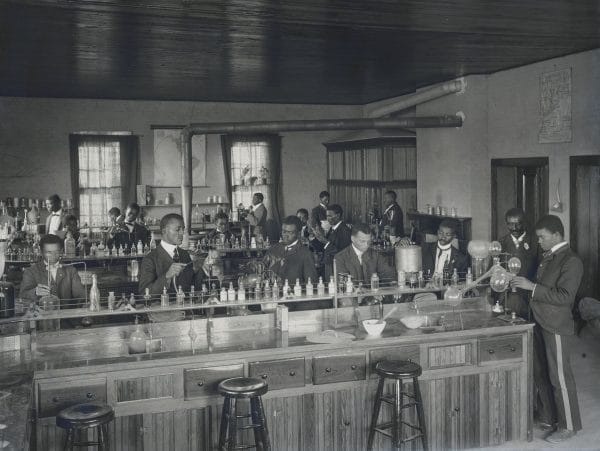 George Washington Carver with Students
Arriving in Tuskegee in October 1896, Carver asserted that he was following God’s will to be “of the greatest good for the greatest number of my people possible.” Such words, as well as his larger salary and unusual demands, including a special room in which he could paint, alienated many faculty members. Never having lived in a predominantly black community for very long, Carver initially associated more with white neighbors in the nearby town of Tuskegee than with his colleagues on campus. In time, however, his remarkable abilities and talent for making friends won him converts. He was especially popular with his students, who found him both inspiring and knowledgeable.
George Washington Carver with Students
Arriving in Tuskegee in October 1896, Carver asserted that he was following God’s will to be “of the greatest good for the greatest number of my people possible.” Such words, as well as his larger salary and unusual demands, including a special room in which he could paint, alienated many faculty members. Never having lived in a predominantly black community for very long, Carver initially associated more with white neighbors in the nearby town of Tuskegee than with his colleagues on campus. In time, however, his remarkable abilities and talent for making friends won him converts. He was especially popular with his students, who found him both inspiring and knowledgeable.
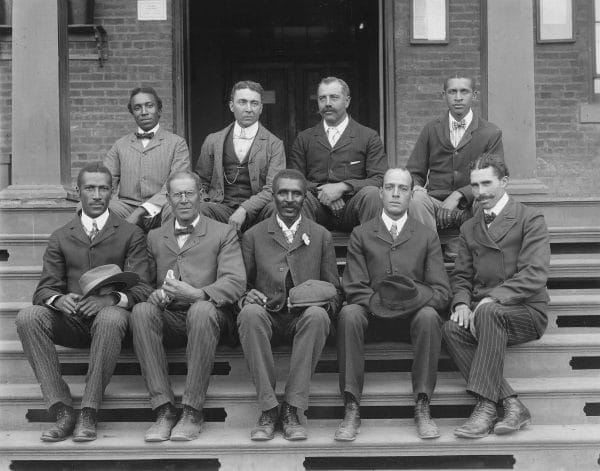 George Washington Carver and Staff
Carver likely found 1890s Alabama more of a “mission field” than he might have anticipated. His time at Iowa State had not prepared him for the facilities and student body at Tuskegee or for life as a black man in the Deep South. The very year he arrived, the U.S. Supreme Court ruled in Plessey v. Ferguson that segregation was legal. In the Midwest, Carver had encountered sporadic hostility, but in the South, whites had created a system of legalized repression to maintain white supremacy. Carver also encountered incredible poverty in the Cotton Kingdom. The worldwide demand for cotton had enriched the South before the Civil War. The process of growing cotton, however, depleted the soil. By the 1890s, the income from cotton cultivation was too meager to support both the landowners and the agricultural workforce. Unable to acquire land of their own, displaced field hands ended up as sharecroppers, working others’ land in return for a portion of the crops. Most had to borrow against future harvests, and contract and debtor laws forced them to stay and work essentially for free if they owed landowners money. As a result many people were trapped in a cycle of debt, forcing them to work under conditions little changed from the days of slavery.
George Washington Carver and Staff
Carver likely found 1890s Alabama more of a “mission field” than he might have anticipated. His time at Iowa State had not prepared him for the facilities and student body at Tuskegee or for life as a black man in the Deep South. The very year he arrived, the U.S. Supreme Court ruled in Plessey v. Ferguson that segregation was legal. In the Midwest, Carver had encountered sporadic hostility, but in the South, whites had created a system of legalized repression to maintain white supremacy. Carver also encountered incredible poverty in the Cotton Kingdom. The worldwide demand for cotton had enriched the South before the Civil War. The process of growing cotton, however, depleted the soil. By the 1890s, the income from cotton cultivation was too meager to support both the landowners and the agricultural workforce. Unable to acquire land of their own, displaced field hands ended up as sharecroppers, working others’ land in return for a portion of the crops. Most had to borrow against future harvests, and contract and debtor laws forced them to stay and work essentially for free if they owed landowners money. As a result many people were trapped in a cycle of debt, forcing them to work under conditions little changed from the days of slavery.
Iowa State had trained Carver in the newest science-based techniques of agriculture, but most were too expensive to be useful to sharecroppers. Carver quickly recognized that the principal obstacles to black advancement were the burden of debt and an overdependence on cotton. He spent the next 25 years of his career seeking solutions to both problems. In the process,
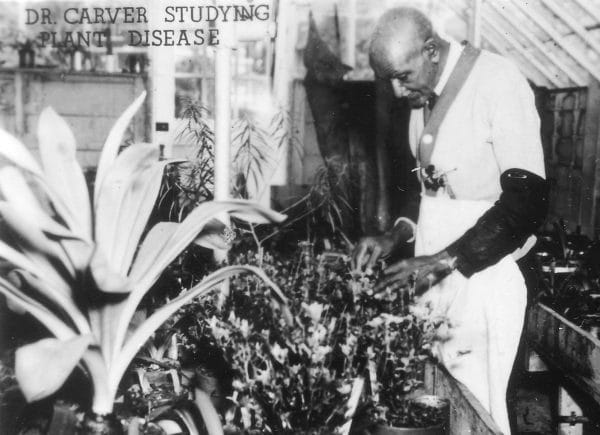 George Washington Carver Studying Plants
he placed himself at the forefront of agricultural extension efforts and became a leader in the evolving field of appropriate or sustainable technology. In 1887, agricultural research in the United States became centered in experiment stations established by the Hatch Act. At first, federal funds went only to white land-grant colleges, but in the 1890s Congress established black land-grant institutions and required segregated states to provide limited research funds to black institutions. Tuskegee opened its agricultural experiment station the year Carver arrived, but it received far less funding than the station at the nearby all-white Agricultural and Mechanical College in Auburn, Lee County. By necessity, as well as philosophy, Carver’s station was geared to the “man fartherest down.” His research focused on finding substitutes for expensive commercial products so landless farmers would need to borrow as little as possible. Thus Carver used available and renewable resources to produce needed commodities. For example, he advocated cultivation techniques requiring no commercial fertilizer and explained how to use native clays to make paints and other products.
George Washington Carver Studying Plants
he placed himself at the forefront of agricultural extension efforts and became a leader in the evolving field of appropriate or sustainable technology. In 1887, agricultural research in the United States became centered in experiment stations established by the Hatch Act. At first, federal funds went only to white land-grant colleges, but in the 1890s Congress established black land-grant institutions and required segregated states to provide limited research funds to black institutions. Tuskegee opened its agricultural experiment station the year Carver arrived, but it received far less funding than the station at the nearby all-white Agricultural and Mechanical College in Auburn, Lee County. By necessity, as well as philosophy, Carver’s station was geared to the “man fartherest down.” His research focused on finding substitutes for expensive commercial products so landless farmers would need to borrow as little as possible. Thus Carver used available and renewable resources to produce needed commodities. For example, he advocated cultivation techniques requiring no commercial fertilizer and explained how to use native clays to make paints and other products.
Attacking the over-dependence on cotton, Carver tried to convince land owners to allow sharecroppers to plant other crops. To further this effort, he researched new uses for various crops, including sweet potatoes and cow peas, to make them more appealing to landowners as well as to provide alternatives to purchased goods for sharecroppers. Practicing what he called “cookstove chemistry,” he developed hundreds of products from easily grown crops and local natural resources, including a nutritious milk made from peanuts, flour from sweet potatoes, and house paints made from native clays. Carver was especially interested in peanuts, because they helped to replenish the soil and provided a much-needed source of protein to poor landless farmers.
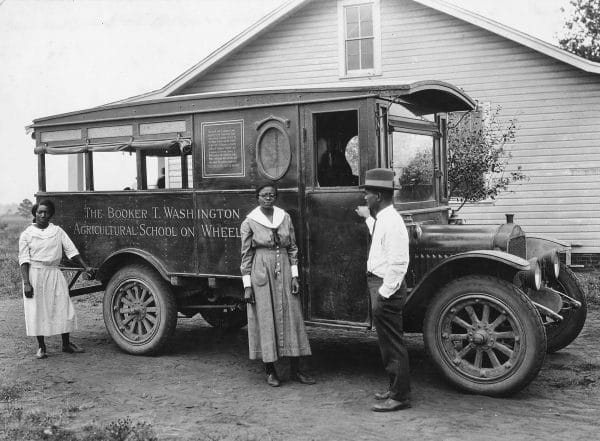 Tuskegee Institute Movable School
Agricultural research is worthless unless farmers actually use the knowledge. Because Alabama sharecroppers were limited by both time and literacy, Carver developed extension services suited to their needs, including two-day agricultural conferences at fairs and short courses in agriculture offered at night or during slack seasons. Eventually, Carver decided to bring instruction directly to the farmers in the fields. Beginning with informal trips into the countryside, Carver eventually developed what was called the “Movable School,” a wagon (and later a truck) that was outfitted with educational and demonstration materials and that was operated for decades by Carver’s former student Thomas Monroe Campbell.
Tuskegee Institute Movable School
Agricultural research is worthless unless farmers actually use the knowledge. Because Alabama sharecroppers were limited by both time and literacy, Carver developed extension services suited to their needs, including two-day agricultural conferences at fairs and short courses in agriculture offered at night or during slack seasons. Eventually, Carver decided to bring instruction directly to the farmers in the fields. Beginning with informal trips into the countryside, Carver eventually developed what was called the “Movable School,” a wagon (and later a truck) that was outfitted with educational and demonstration materials and that was operated for decades by Carver’s former student Thomas Monroe Campbell.
For 20 years, Carver labored in relative obscurity to improve the lives of Alabama sharecroppers. Following the death of Booker T. Washington in 1915, however, Carver quickly rose to international fame. Recognition came first from his white peers in agricultural research. In 1916, he joined the advisory board of the National Agricultural Society and became a fellow of Great Britain’s Royal Society for the Arts. The general public became more aware of Carver, however, after his testimony in the U.S. House of Representatives in favor of peanut tariffs in 1921. This launched his career as the “Peanut Man.” He soon began spending more time on the lecture circuit than in the classroom and became known mainly as a chemistry wizard who dazzled his audiences with the sheer multitude of peanut products.
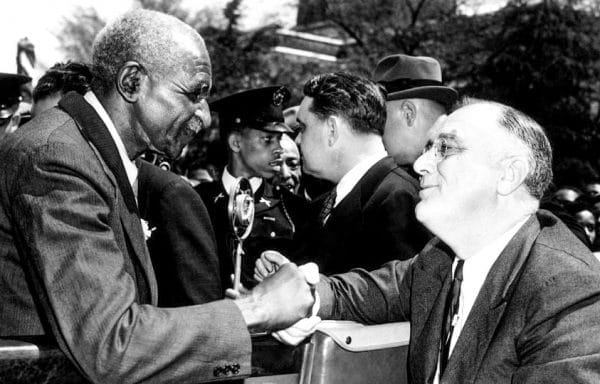 Carver and Pres. Franklin D. Roosevelt
Distracted from his most important contributions, Carver spent much of the 1920s attempting to commercialize his products through the Carver Products Company, but products meant to replace purchased goods could hardly succeed commercially. They were primarily intended as fallback goods that poor farmers could make from available resources. Nevertheless, Carver’s fame soared even as his significant contributions declined. Numerous groups adopted Carver as a symbol of their causes. The peanut industry exploited his work. His open reliance upon God for inspiration in his research led numerous religious groups to publicize his words. Groups such as the Commission on Interracial Cooperation and the National Association for the Advancement of Colored People highlighted his abilities in their fight against racism. Conversely, groups supportive of segregation also used Carver’s achievements as evidence racial separation was not a barrier to success.
Carver and Pres. Franklin D. Roosevelt
Distracted from his most important contributions, Carver spent much of the 1920s attempting to commercialize his products through the Carver Products Company, but products meant to replace purchased goods could hardly succeed commercially. They were primarily intended as fallback goods that poor farmers could make from available resources. Nevertheless, Carver’s fame soared even as his significant contributions declined. Numerous groups adopted Carver as a symbol of their causes. The peanut industry exploited his work. His open reliance upon God for inspiration in his research led numerous religious groups to publicize his words. Groups such as the Commission on Interracial Cooperation and the National Association for the Advancement of Colored People highlighted his abilities in their fight against racism. Conversely, groups supportive of segregation also used Carver’s achievements as evidence racial separation was not a barrier to success.
In 1938, Carver worked with Tuskegee to establish the George Washington Carver Museum on the campus to house his paintings, personal items, and scientific materials. It opened in 1941, and despite suffering a fire that consumed most of Carver’s paintings, the museum continues to operate on the campus today and is part of the Tuskegee Institute National Historic Site.
 G. W. Carver Interpretive Museum
By the time of his death on January 5, 1943, Carver was a world-renowned figure. Much of his fame was based upon myth, but his real contributions were significant. Sponsored by the YMCA, he lectured at white colleges, challenging many of the students’ beliefs in segregation and the inferiority of African Americans and establishing close friendships with many of them. His fame also encouraged black students to pursue careers in science. His work improved the lives of hundreds of black Alabamians and was instrumental in pioneering ecologically sound and sustainable technology. In his last years, he also provided a tangible legacy, bequeathing nearly $60,000 to establish the George Washington Carver Foundation at Tuskegee, which continues to provide funding to black researchers in Alabama. Carver is buried in the Tuskegee University Campus Cemetery, as is Booker T. Washington. In 2000, the G. W. Carver Interpretive Museum opened in Dothan, Houston County; it offers exhibits on agricultural history and science as they relate to Carver and his life as well as a hands-on Discovery Zone that encourages children to learn about the scientific process.
G. W. Carver Interpretive Museum
By the time of his death on January 5, 1943, Carver was a world-renowned figure. Much of his fame was based upon myth, but his real contributions were significant. Sponsored by the YMCA, he lectured at white colleges, challenging many of the students’ beliefs in segregation and the inferiority of African Americans and establishing close friendships with many of them. His fame also encouraged black students to pursue careers in science. His work improved the lives of hundreds of black Alabamians and was instrumental in pioneering ecologically sound and sustainable technology. In his last years, he also provided a tangible legacy, bequeathing nearly $60,000 to establish the George Washington Carver Foundation at Tuskegee, which continues to provide funding to black researchers in Alabama. Carver is buried in the Tuskegee University Campus Cemetery, as is Booker T. Washington. In 2000, the G. W. Carver Interpretive Museum opened in Dothan, Houston County; it offers exhibits on agricultural history and science as they relate to Carver and his life as well as a hands-on Discovery Zone that encourages children to learn about the scientific process.
Further Reading
- Adair, Gene. George Washington Carver. New York: Chelsea House, 1989.
- Jones, Allen W. “The Role of Tuskegee Institute in the Education of Black Farmers.” Journal of Negro History 60 (April 1975): 252–67.
- Kitchens, John W., and Lynne B. Kitchens, eds. George Washington Carver Papers at Tuskegee. Microform. Tuskegee, Ala.: Carver Research Foundation, 1975.
- Kremer, Gary R., ed. George Washington Carver in His Own Words. Columbia: University of Missouri Press, 1987.
- McMurry, Linda O. George Washington Carver, Scientist and Symbol. New York: Oxford University Press, 1981.
